Leander-class frigate (Type 12I frigates)
Basic information
Ship measurements
Machine
- 2 * Babcock & Wilcox oil-fired boilers
- 2 * geared steam turbines
- 22,370 kilowatts (30,000 hp)
- 2 * shafts
Personnel
Combat assets
- Radar: Type 965 (air warning radar removed during the Ikara conversion), Type 992 Q, Type 903, Type 974/978
- Sonar: Type 162, 184, 199, & later type 2031 towed array sonar
Initial:
- 2 * 4.5 inch guns (1 * twin mounting Mk6)
- 1 * Seacat surface-to-air missile launcher
- 2 * 20mm guns (single mountings)
- 2 * 40mm Mk VII Bofors (single mountings)initially in first 7 instead of Seacat & 20mm guns
- 1 * ASW Limbo mortar
Batch 1 — Ikara:
- 1 * Ikara Anti submarine missile Launcher
- 2 * Seacat surface-to-air missile Launchers
- 2 * 40mm guns — single mountings
- 2 * triple 324 mm (12.75 in) STWS-1 tubes for Mk 46 and Stingray ASW torpedoes
- 1 * Limbo ASW Mortar
Batch 2 — Exocet/Seacat:
- 4 * MM.38 Exocet anti ship missile launchers
- 3 * Seacat surface-to-air missile launchers
- 2 * 40mm guns — single mountings
- 2 * triple 324 mm (12.75 in) STWS-1 tubes for Mk 46 and Stingray ASW torpedoes
Batch 3 — Exocet/Seawolf:
- 4 * MM.38 Exocet anti ship missile launchers
- 1 * sextuple GWS.25 launcher with 30 sea wolf SAMS
- 2 * 20mm AA guns
- 2 * triple 324 mm (12.75 in) STWS-1 tubes for Mk 46 and Stingray ASW torpedoes
- Initial and Batch 1: 1 * Westland Wasp ASW helicopter
- Batch 2 and Batch 3: 1 * Westland Lynx HAS.Mk 2 ASW helicopter
The Leander-class, or Type 12M frigates, comprising twenty-six vessels, was among the most numerous and long-lived classes of frigate in the Royal Navy's modern history. The class was built in three batches between 1959 and 1973. It had an unusually high public profile, due to the popular BBC television drama series Warship. The Leander silhouette became synonymous with the Royal Navy through the 1960s until the 1980s. As of February 2015, only two Leander-class frigates survive, serving in the Ecuadorian Navy, both have now been scrapped.
Design
The policy adopted by the Royal Navy during the 1950s of acquiring separate types of frigates designed for specialised roles (i.e. anti-submarine, anti-aircraft and aircraft direction) had proved unsatisfactory. Although the designs themselves had proved successful, the lack of standardisation between the different classes led to increased costs during construction and also in maintenance once the ships became operational. Furthermore, it was not always possible to have the ships with the required capabilities available for a specific task. The first move towards creating a truly general purpose frigate came with the Type 81 Tribal class which was initially ordered in 1956. The 24 knot speed of the Tribals was considered the maximum possible for tracking submarines with the new medium range sonars, entering service. The type 81 gas turbine saw the frigates underway, without hours flashing up steam turbines and provision of a helicopter for long range attack were considered essential, in the nuclear age. These ships were mainly intended to operate in the tropics, but lacked the speed and armament required, for the priority post Suez, fleet carrier escort role, East of Suez, where fast radar picket capability was important, as much as anti submarine capability so the new frigates, would combine the roles of the T12 and T61. The fully airconditioned RNZN variant, which gave all the crew a bunk and cafiteria messing, of the Rothesay HMNZS Otago and a RNZN Commissioned design study for a more fully helicopter capable, Type 12 frigate, which also assesed whether the Type 12 could carry 2 larger Wessex AS helicopters, was used as the basis of the RN Leander Improved Type 12 design.
On 7 March 1960, the Civil Lord of the Admiralty C. Ian Orr-Ewing stated that the «Type 12 Whitby-class anti-submarine frigates are proving particularly successful… and we have decided to exploit their good qualities in an improved and more versatile ship. This improved Type 12 will be known as the Leander class. The hull and steam turbine machinery will be substantially the same as for the Whitbys. The main new features planned are a long-range air warning radar, the Seacat anti-aircraft guided missile, improved anti-submarine detection equipment and a light-weight helicopter armed with homing torpedoes. We shall also introduce air conditioning and better living conditions.» The 1963 edition of Jane's Fighting Ships described it as a «mainly anti-submarine but flexible and all purpose type».
The difference between the Leanders (Type 12M) and the Whitbys (Type 12) was most obviously that the stepped quarterdeck of the Type 12 had been done away with, resulting in a flush deck, with the exception of the raised forecastle. The superstructure had been combined into a single block amidships and a new bridge design gave improved visibility. A hangar and flight deck were provided aft for the Westland Wasp light anti-submarine helicopter, which was still at the prototype stage when the first ships were ordered. The ship was air conditioned throughout and there were no portholes in order to improve nuclear, biological and chemical defence. The ships were all given names of characters from classical mythology which had previously been given to Royal Navy cruisers.
The Y160 boiler variant used on the Batch 3 Leanders (such as Jupiter) also incorporated steam atomisation equipment on the fuel supply so the diesel fuel entering the boilers via the three main burners was atomised into a fine spray for better flame efficiency. Some ships with Y100 Boilers were also converted to steam atomisation, HMS Cleopatra being one of them. The superheat temperature of the Y160 was controlled manually by the boiler room petty officer of the watch between 750–850 °F (399–454 °C) and the steam supplied to the main turbines was at a pressure of 550 psi (3,800 kPa). The Leander-class frigates did have Babcock & Wilcox boilers but of a more conventional two-drum design, one water drum and one steam drum, much like a Yarrow boiler without the second water drum. The water drum was offset to one side and below the furnace and steam drum. The two boilers fitted were 'handed' with the water drum inboard on both. Many Leanders had six burner furnaces (known as Five and a Half Boilers) and the output was varied by altering the number of burners in use.
- Comments
 en
en ru
ru uk
uk
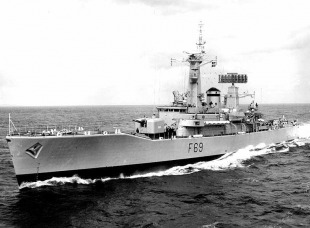
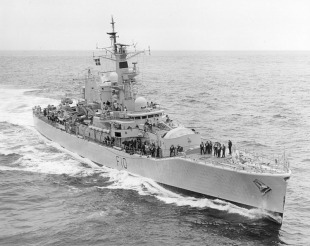
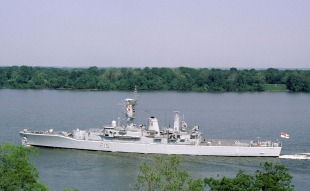
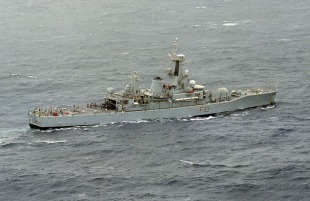
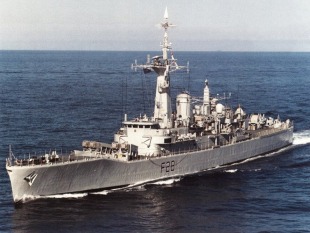
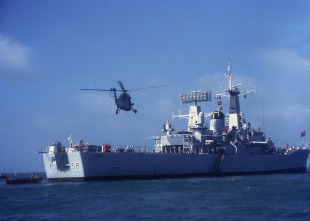
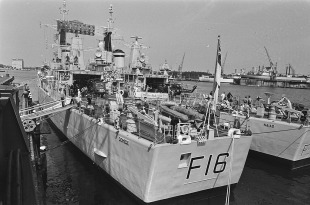
 Royal New Zealand Navy
Royal New Zealand Navy Pakistan Navy
Pakistan Navy Ecuadorian Navy
Ecuadorian Navy Chilean Navy (Armada de Chile)
Chilean Navy (Armada de Chile) Royal Navy
Royal Navy Indian Navy
Indian Navy